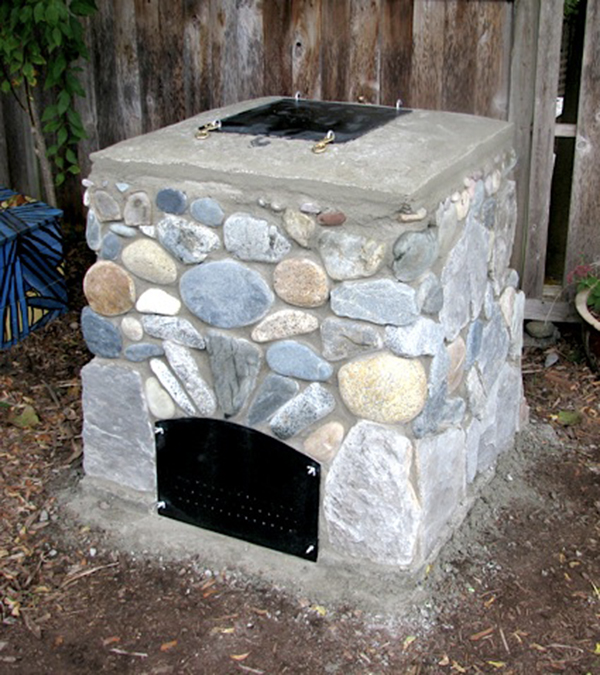Southwest Sierra #102 – Springtime in Alleghany
May 15, 2025

The author’s bear-proof Compost Bin no. 3
This week, I am switching gears and returning to the present. Spring is absolutely my favorite time of the year here in the Sierra Nevada mountains. We recently traveled from Alleghany to Downieville via Mountain House Road meandering through the blooming dogwoods and past waterfalls flanked by ferns and moss. Passing through Goodyear’s Bar the lilacs were incredible! There is one particularly large dark purple bush that I am told is a French Lilac, but all of them were in full bloom and fuller than in most years.
Springtime bouts of extremely warm weather get us gardeners in a frenzy. We can’t help ignoring the official “Frost Free” date. For those who do not know, the “Frost Free Date” is when it is considered safe to put tender plants, such as tomatoes and peppers in the ground. For Alleghany it is June 1st. Usually we don’t get any hard freezes after May 1st and those tender plants will survive a light frost or even a heavy snow if you cover them up. Plastic buckets, cardboard boxes and clay pots can be employed for this purpose. To make it easier on yourself, in the event of an unexpected frost, round up the covers in advance, ready to go. I have seen snow in May more times that I care to remember, but nary a hard frost.
While I am on the topic of gardening, I thought that I’d revisit the search for a bear-proof compost bin. Regarding the recently enacted California laws about organic waste, we composters are ahead of the curve. However, in my opinion this shouldn’t be a law. What is that saying from Don Russell about overzealous laws making outlaws of honest men? I concur. These “one-size-fits-all” laws, do not take things like living in bear country into consideration.
If Sierra County did want to build a composting facility, (or facilities) a bear-proof one could be built out of cinder blocks with metal doors. It would need good drainage and ventilation, and the smell would be BAD. You would need at least two cells to rotate between. Ideally you would have enough space to fill one and wait at least 6 months before mucking it out. The doors would need to be big enough for a small loader to access the inside for clean-out (a removable metal top would also help). The introduction of red worms would speed up the decomposition process and meat scraps would attract flies. (I don’t add meat scraps to my compost, but my limited understanding of the new law is that all wet garbage is supposed to be separated out and that would include meat scraps). As unpleasant as they are, the maggots would also speed up the decomposition process. The end result would be amazing fertilizer that could be given away, used in parks, you name it.
On a smaller personal scale, my “bear tough” trash can with the fiberglass patch mentioned in SS# 62 remains untested, standing intact. I have been using a metal drum with a door that we found and strapped to a large log in the yard. I believe the drum was originally made to store explosives. It is made of a very heavy gauge metal with a hasp on the door. We drilled holes in the side that sits on the ground for worm ingress and egress, and it had a couple of threaded plugs that we removed for ventilation. There has been one bear attempt on it this spring. The bear managed to detach it from the log, but didn’t get in. It is now secured more tightly to the log. This bin is not something that could be reproduced very easily, and we found it by chance. I am worried about it getting too hot inside during the summer. I think that masonry options are the best bet, as they would not overheat or freeze inside as easily.

A good example of a masonry compost bin.
The fruit trees don’t know about the “Frost Free” date and they bloom when they bloom. This year they bloomed about a month ago, in mid-April and are already setting fruit. Now we watch and wait, hoping for no hard freezes or damaging hail. Our “on again off again” warm winter and springtime weather is hard on perennial plants and trees. I have noticed that in Montana, where there is a deep freeze all winter, the fruit trees and lilacs have a better constitution. They just seem stronger and healthier, but I’ll take our Sierra Nevada winters over their minus 30-degree winter days anytime. By comparison, Alleghany feels like a warm place to spend the winter.
Featured Articles

Mountain Brewfest Returning to Downieville with New Vendors →
August 27, 2025
Downieville Mountain Brewfest returns September 6 with new vendors and live music, supporting the local firehouse.
Search Continues for Missing Goodyears Bar Resident Gil Clark →
August 18, 2025
Nevada County to Increase Off-Highway Patrols Labor Day Weekend →
August 26, 2025
County Explores Options for Downieville Veterans Memorial →
August 20, 2025
Kiley Introduces Bill Banning Mid-Decade Redistricting, Not Gerrymandering →
August 22, 2025